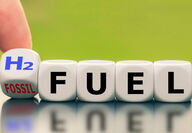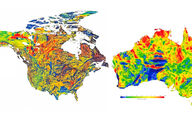Sorted by date Results 1 - 20 of 20

A growing imbalance in the supply and demand for rare earths is creating a challenge for the companies that produce this suite of technology elements and an opportunity for the scientists seeking ways to leverage their unique properties in new and intriguing ways. While it is true that the global transition to zero-carbon energy and transportation is creating new rare earths demand that threatens to outstrip the global supply, the real disparity has more to do with which of... Full story

As the White House continues to dole out hundreds of billions of dollars to position America as the global leader in clean energy and digital technologies, Beijing initiates a strategy to put America in check with the global economy equivalent of pawns. These pawns in the technology chess match between the U.S. and China are gallium and germanium, a pair of semiconductor metals used to make the computer chips essential to every facet of modern life. Before all the major news o... Full story

Data Mine North launched the first edition of Critical Minerals Alliances in 2021 with the hopes that this annual magazine would play some small role in helping to build alliances "that are not crippled by irreconcilable differences between organizations and individuals that do not always see eye-to-eye but strengthened by a spectrum of ideologies with a common goal – a healthy, prosperous, and exciting future for humankind." Today, the alliances envisioned by the Data Mine N... Full story

Every electric vehicle rolling off an assembly line increases the demand for graphite by an average of around 160 pounds. With more than 30 million EVs expected to hit global highways each year by 2030 and upwards of 45 million by 2045, the transition to e-mobility will require up to eight times more graphite than was mined globally during 2022. While graphite has not received the attention of other EV battery ingredients such as cobalt, lithium, and nickel, this highly... Full story

Everyone agrees that historically enormous quantities of copper are essential to wiring a world in which low-carbon electricity delivered via powerlines supplants fossil fuels pumped through pipelines as the energy solution of choice. The federal entity charged with compiling the list of minerals critical to the United States, however, disagrees with nearly every company, organization, and person associated with the clean energy supply chain on the criticality of the... Full story

After 50 years of scrubbing the emissions from fossil-fueled transportation and industry, platinum group metals are finding new roles as catalysts for the transition to a low-carbon energy future. "Platinum group metals (PGM) are critical for today's energy sector industrial base and will play a key role in tomorrow's decarbonized economy," U.S. Department of Energy inked in an informational brochure on these transitional metals, also known as platinum group elements. PGMs... Full story

Compile national-scale datasets to assist tri-national critical minerals mapping initiative. Part of a larger collaboration to better understand the critical minerals potential across Australia, Canada, and the United States, the federal geological surveys from the three countries have merged national-scale geological, geophysical, and mineral resource information into a single dataset that is expected to enhance critical mineral discovery. "Geology doesn't stop at the border... Full story

From rare earths in Northern Maine to lithium in Southern California and graphite in Alaska, the U.S. Geological Survey is on a mission to discover minerals critical to the nation's economy and clean energy goals on American soil. Or, more accurately, under American soil. This nationwide endeavor is officially called the Earth Mapping Resources Initiative, but is better known as Earth MRI, a clever moniker that reflects the earth penetrating scans that are providing... Full story

Lithium is an indispensable element in the clean energy transition for several key reasons; like all alkaline metals on the periodic table, it has one more electron than it strictly needs, and this tendency to shed electrons makes it well-suited for passing them back and forth between cathode and anode, charging and discharging thousands of times without degradation. Pure lithium does not occur in nature, but traces are found throughout nearly all igneous rocks, mineral... Full story

While most leaders in the clean energy sector strongly indicate the concept of solid-state batteries is better, a few hurdles have long held this superior rechargeable battery in the realm of pacemakers and smartwatches, and out of electric vehicles where they are desperately needed. Solid-state technology replaces the liquid electrolyte in lithium batteries with a solid ceramic or polymer material. This increases energy density, stability, and heat resistance. For EV... Full story

Separating your plastics, paper, metals, and food waste has generally been a personal choice throughout most of modern recycling history. However, current demand for resources predicts we won't have enough to support net-zero carbon emissions by 2050. Hence, now is the best time for consumers to become educated and self-determined with their buying power, manufacturers to begin considering recycling as part of the initial design, and a new circular economy that resurrects a tr... Full story

Aluminum has been classified as critical by the United States, European Union, Canada, and even China. At first glance, one may wonder how such a ubiquitous metal could possibly be critical. The answer is simply that aluminum is so widely used that supply, if endangered, could devastate an economy. In 2020, the World Bank identified aluminum as a "high-impact" and "cross-cutting" metal in all existing and potential green technologies. In spite of this, due to high energy... Full story

Powering nearly 10% of the world's energy needs and roughly 20% of America for over 50 years, nuclear energy is a highly controversial power provider that ticks all the boxes for zero-emission electricity. Much like most contemporary fuels, running these reactors takes something dug from the earth – uranium. In 2017, the United States Geological Survey was charged with identifying which minerals and metals are critical to the U.S. Its original list of 35 critical minerals, f... Full story

As the cracks in the wall continue to chill the bones of an ill-prepared American clean-energy economy, attention has been paid to nearly every facet imaginable to obtain the minerals critical to fuel a zero-carbon future; however, all has seemingly been quiet on the unconventional front. Repeated time and time again during the ongoing transition, U.S. policymakers are becoming increasingly concerned about the overreliance on China for the minerals and metals essential to... Full story

Visual Capitalist infographic shines light on America's heavy reliance on China, others for critical minerals. A recent infographic produced by Visual Capitalist raises both figurative and literal red flags when it comes to America's reliance on imports for the minerals and metals critical to the nation's high-tech sectors, military readiness, and envisioned low-carbon energy future. While the United States' heavy dependence on other countries for critical minerals is not new... Full story

There is nearly a $1 trillion chasm between where the United States' lithium battery supply chain is today and where it needs to be by 2035 in order to build the envisioned green energy future where electric vehicles are charged with low-carbon energy. Roughly 40% of this investment will need to go toward ensuring there is a plentiful supply of cobalt, graphite, lithium, nickel, and other battery materials. Simon Moores, CEO of Benchmark Mineral Intelligence and one of the... Full story

The United States has rich deposits of copper, cobalt, graphite, lithium, nickel, rare earths, and other mined commodities needed to build the clean energy future. The often decade-long mine permitting timeline in the U.S., however, means that many of these domestic critical mineral sources will be hard-pressed to get developed in time to help meet the climate goals laid out by the White House. This extraordinarily long federal permitting process for large projects has global... Full story

From promising solid-state battery technology that could eliminate range anxiety for electric vehicle owners to solar panels and thermoelectric devices that transform sunshine and heat into low-carbon energy, tellurium is emerging as a secret ingredient of the clean energy future. "It has flown largely under the radar, even though it's essential for cadmium-telluride solar panels and new lithium-tellurium batteries that could revolutionize energy storage," said Tyrone... Full story

Still overshadowed by lithium but no less significant, cobalt falls within a unique category as a critical mineral not only for its properties but also for its controversial supply. As a fundamental component necessary for nickel-cobalt-manganese (NMC) lithium-ion batteries, cobalt warranted its place as a critical mineral vital to the zero-carbon transition due to the necessity of those batteries to power a clean, emission-free future. Its critical uses, however, go far... Full story

While lithium has been the poster child for optimism and controversy in equal measure, nickel has its own crucial role to play in the batteries powering the clean energy future – increasing range and capacity – but is traditionally carbon-heavy to produce. For nickel, the industry's focus has been twofold – obtaining enough and moving the needle between untenable quantities of emissions from mining and processing and the battery and alloying metal's necessary inclusion in ne... Full story